Quinoa:
What is it?, history, cultivation, nutritional value, uses, recipes, and more...
Quinoa is a grain native to the Andean region and holds significant importance due to its nutritional, agronomic, and economic value. In the last decade, its cultivation has expanded notably in non-traditional areas within and outside of Peru, driven by its nutritional properties for combating hunger, malnutrition, and poverty.
Índice
What is Quinoa?
Quinoa, also known as quínoa or quinoa, is a plant belonging to the subfamily Chenopodioideae of the amaranth family. While technically a seed, it is commonly referred to and categorized as a whole grain. It is native to the Andes of Bolivia, Chile, and Peru, where it is primarily produced.
Quinoa is an annual herbaceous shrub with various colors, broad leaves, dicotyledonous, and an average height of 1 to 2 meters. Its stem may or may not have branches, depending on the variety and/or planting density, and it features lobed and brittle leaves. The main root typically measures 20 to 25 cm in length and forms a dense network of rootlets that penetrate the soil as deep as the plant’s height. Panicles or inflorescences usually grow at the tip of the plant and sometimes under the stem. The flowers are small, lacking petals (only having sepals), known as sepalous perianth. They are characterized by the presence of hermaphroditic and female flowers on the same inflorescence. Three types of flowers have been found in quinoa: hermaphroditic, pistillate, and androsterile. The fruit is dry and measures about 2 mm in diameter (containing 250 to 500 seeds per grain), surrounding the calyx, which shares the same color as the plant. The seed is usually smooth and comes in various colors such as white, pink, orange, red, brown, and black. The weight of the embryo constitutes 60% of the seed’s weight, forming a ring around the endosperm that detaches when the seed is cooked.
History of Quinoa
Based on historical evidence, quinoa was domesticated by the peoples of the Americas between 3000 and 5000 BC. Archaeological findings of quinoa have been discovered in graves in Tarapacá, Calama, and Arica in Chile, as well as in different regions of Peru. Upon the arrival of the Spanish, quinoa was already well-developed technologically and widely distributed within and beyond the Inca territory. Pedro de Valdivia was the first recorded Spanish individual to mention quinoa cultivation, noting that indigenous people also grew quinoa for sustenance.
Garcilaso de la Vega, in his Royal Commentaries, described quinoa as one of the second grains cultivated on Earth, resembling a little bit of millet or small rice. He also referred to the first shipment of quinoa seeds to Europe, which unfortunately arrived dead, possibly due to high humidity during the maritime journey.
Similarly, Cieza de León (1560) indicated that quinoa was cultivated in the highlands of Pasto and Quito, mentioning that in these cold lands, maize was grown little, and quinoa was abundant. Patiño (1964) also mentioned that La Paz’s records referred to quinoa as a plant used for indigenous people’s food. Finally, geographer Alexander Von Humboldt, while visiting Colombia, noted that quinoa had always been present among the inhabitants of Cundinamarca.
In Peru, along with maize, quinoa was considered a major source of carbohydrates for both human and animal consumption. Quinoa was cultivated on significant expanses of land in inter-Andean valleys and the highlands, while maize was grown in coastal areas and inter-Andean valleys. It’s estimated that there were approximately 400,000 hectares of quinoa. However, with the arrival of the Spanish, crops like barley, wheat, beans, peas, and oats were introduced, reducing quinoa’s area significantly, particularly in inter-Andean valleys. The largest areas were maintained in the Altiplano, transitioning from a staple food to a underutilized crop. These new crops are currently grown at altitudes above 3000 meters.
It’s believed that before domestication, wild quinoa was used for its leaves and seeds as food for humans and animals. Early evidence of its morphology can be found in Tiahuanaco culture ceramics, depicting the quinoa plant with multiple panicles along the stem, representing one of the most primitive races of the plant. From a genetic variability standpoint, it can be considered an oligocentric species, with a center of origin that has a wide distribution and multiple diversifications.
In the 1980s, a global revaluation of organic and nutritious foods began, leading to quinoa transforming from a underutilized subsistence crop for Andean farmers to one of the most valuable exports from the Andean nations of Bolivia and Peru in the past 20 years. This rediscovery has significantly raised its price at the local level, making it a highly profitable crop with an export market.
The Inter-American Institute for Cooperation on Agriculture (IICA, 2015) recognized quinoa as a fundamental crop in the fight against global hunger. Its remarkable characteristics have drawn the attention of continents such as Africa, Asia, Europe, and North America, where demand has significantly increased. The UN declared 2013 as the “International Year of Quinoa” (AIQ) in recognition of Andean peoples who have maintained, protected, and preserved this crop as food for present and future generations. This recognition is well-deserved, considering that indigenous peoples, through their traditional knowledge and harmonious practices with the land and nature, have safeguarded this food for over 7,000 years. Secretary-General Ban Ki-moon stated that quinoa is a food that can contribute to achieving Millennium Development Goals and post-2015 development strategies.
In recent years, quinoa has become a highly sought-after food due to its nutritional benefits. It’s the only plant-based food that contains all essential amino acids, trace elements, and most vitamins required by the human body, and it’s (largely) gluten-free. Additionally, it has the capacity to adapt to various ecological environments and climates; it’s drought-resistant, thrives in poor soils and high salinity, can be grown from sea level to an altitude of 4000 meters, and can withstand temperatures ranging from -8 to 38°C.
NASA included quinoa in the Controlled Ecological Life Support System (CELLS) as an ideal product for inclusion in space missions and when crops need to be grown in a spaceship.

Common Name of Quinoa
| Spanish | Quinua, quinoa y quínoa |
| Quechua | Kinua, kinuwa, kitaqañiwa, kuchikinwa, ayara, kiwicha, qañiwa, qañawa (las tres últimas son plantas parecidas y cultivadas en Bolivia y Perú; sus granos son más pequeños y oscuros). |
| Aymara | Tupapa supha, jopa, jupha, juira, ära, qallapi, vocal, linquiñique. |
| English | Quinoa |
Scientific Name of Quinoa
Chenopodium pallidicaule
Taxonomy of Quinoa
| Kingdom | Plantae |
| Division | Magnoliophyta |
| Class | Magnoliopsida |
| Order | Caryophyllales |
| Family | Amaranthaceae |
| Subfamily | Chenopodioideae |
| Tribu | Chenopodieae |
| Gender | Chenopodium |
| Species | Chenopodium quinoa |
Synonymy of Quinoa
- Chenopodium album subsp. quinoa (Willd.) Kuntze
- Chenopodium album var. quinoa (Willd.) Kuntze
- Chenopodium album f. subspontaneum Kuntze
- Chenopodium ccoyto ToroTorrico
- Chenopodium ccuchi-huila Toro Torrico
- Chenopodium chilense Pers. nom. inval.
- Chenopodium guinoa Krock.
- Chenopodium hircinum f. laciniatum (Moq.) Aellen
- Chenopodium hircinum var. quinoa (Willd.) Aellen
- Chenopodium hircinum f. rubescens (Moq.) Aellen
- Chenopodium hircinum f. viridescens (Moq.) Aellen
- Chenopodium nuttalliae Saff.
- Chenopodium purpurascens var. punctulatum Moq.
- Chenopodium quinoa var. laciniatum Moq.
- Chenopodium quinoa var. lutescens Hunz.
- Chenopodium quinoa var. melanospermum Hunz.
- Chenopodium quinoa subsp. milleanum Aellen
- Chenopodium quinoa var. orbicans Murr
- Chenopodium quinoa f. purpureum Aellen
- Chenopodium quinoa var. rubescens Moq.
- Chenopodium quinoa var. viridescens Moq.
Etymology of Quinoa
The term “Chenopodium” comes from the Greek words χήν (chén), meaning “goose,” and πóδιον (pódion), meaning “foot,” in reference to the shape of the leaves. The specific name of quinoa is the transcription from Quechua to Spanish of “kinwa” (occasionally “Qin-wah”), which means “mother of all seeds” (Antropocene, 2019).
Other sources assert that the term means “type of plant with edible leaves” (deChile, n.d.).
Cultivation, Distribution, and Habitat of Quinoa
- Habitat
- Distribution
- Cultivation
Habitat of Quinoa
Quinoa is native to South America and has a specific origin in the Andes of Bolivia, Chile, and Peru. It extends to all countries in the Andean region, from Colombia (Pasto) to the Northwest of Argentina (Jujuy and Salta) and central Chile.
It grows from sea level up to 4000 meters in the Andes, with its most common altitude starting from 2500 meters.
It is a resilient, tolerant, and water-efficient plant with extraordinary adaptability. It can tolerate temperatures ranging from -4°C to 38°C and grow in relative humidities from 40% to 70%. Tapia and Ames (2007) note that the optimal altitude for quinoa in the valley ranges from 2000 to 3400 meters above sea level, and for quinoa in the Altiplano, it ranges from 3800 to 4000 meters above sea level. In general, the best crop development occurs between 2800 and 3900 meters above sea level in the Andean region (Soto, 2010).
The Andean region, particularly the shores of Lake Titicaca, showcases the greatest diversity and genetic variation of quinoa.
Distribution of Quinoa
Quinoa is a crop that is spreading worldwide, found in more than 70 countries. It's important to note that 92% of its production was in Bolivia and Peru as of 2008, with the remaining 8% primarily in the United States, Ecuador, Argentina, and Canada.
The main producing countries are Argentina, Bolivia, Ecuador, the United States, Chile, Colombia, and Peru, although its cultivation is expanding to various countries in Europe and Asia with high levels of yield.
Quinoa cultivation is spreading and is now produced in over 70 countries, including France, England, Sweden, Denmark, the Netherlands, and Italy. It's also successfully developing in Kenya, India, and the United States.
Production Regions: In the Andes of Argentina, Bolivia, Chile, Colombia, Ecuador, and Peru.
In Peru, quinoa is cultivated in 19 out of 24 departments; however, the region of Puno holds the highest proportion of national production based on statistical records.
Facing the challenge of increasing the production of quality food to feed the global population in the context of climate change, quinoa offers an alternative for countries experiencing food insecurity.
Cultivation of Quinoa
Sunlight Requirement: It exhibits various photoperiods, from short-day requirements for flowering near the equator to light-insensitive conditions for growth in Chile.
Precipitation: Between 300 and 1000 mm, rainfall conditions vary depending on the species and/or country of origin. Varieties from southern Chile require ample rain, while those from the Altiplano require very little. Generally, it grows well with good rainfall distribution during growth and development, and it withstands dry conditions, especially during maturation and harvesting.
Altitude: It grows from sea level in Chile and Peru up to 4000 meters in the Andes, but it typically thrives between 2500 and 4000 meters.
Low Temperatures: It tolerates a wide range of climates, as the plant is not affected by cold temperatures (-1°C). However, the plant's flowers are sensitive to cold, so mid-season frosts in the Andes can destroy the crop.
High Temperatures: The plant can tolerate temperatures over 35°C, but it doesn't thrive.
Soil Types: It can grow in a wide variety of soils with pH ranging from 6 to 8.5.
Management Techniques: In the Andes, it's often broadcast onto the ground. Sometimes it's sown in narrow and shallow rows. The seedbed must be well-prepared and well-drained, as the seeds can easily die from waterlogging. The plant grows rapidly, with a growth period of 90 to 120 days, depending on the varieties planted and temperature. Mechanized production is successful in South America. Machinery used for grains and oilseeds can be used for quinoa with minor or no modifications.
Limitations and Diseases: Pests or diseases don't cause significant losses. The main issue is weeds growing near the crop.
Harvesting: It has highly variable maturity periods, making mechanization challenging. This is why, for many years, harvesting was done manually by farmers themselves, and machinery was very rarely used. Productivity is around 3000 kg/ha and sometimes reaches up to 5000 kg/ha, comparable to wheat harvesting in the Andean region. When harvesting the seeds, they are first threshed, then winnowed to remove the husks, and finally carefully dried since they need to be completely dry for storage, as they germinate quickly. Quinoa seeds must be processed to remove bitter saponins. At a household level, this process involves soaking, washing, and rubbing the seeds. At commercial levels, mechanical grinding or simultaneous washing and grinding are the most common methods.
Geographical Distribution of Quinoa

The department of Puno serves as the foundation of national production, followed by Ayacucho; and starting from 2016, in addition to the aforementioned departments, the departments of Apurímac and Arequipa; also, to a lesser extent, Cusco and Junín.
Seasonal Availability of Quinoa
- April, May, June, July
Varieties of Quinoa
In Peru, there are 3,000 ecotypes of quinoa (INIA, 2018), and it is currently the world’s primary producer of this grain (ODEPA, 2017). However, there are diverse varieties of quinoa depending on the country of production.
Commercial quinoa varieties have been selected from agroecological groups that possess specific characteristics inherent to the environment in which they evolved and were domesticated.
-
Coastal Quinoas
These can be found in the Linares and Concepción areas (Chile) at 36° south latitude. They are relatively robust plants, ranging from 1.0 to 1.4 meters in height, with branching and producing transparent cream-colored seeds (chullpi type). These quinoas share morphological similarities with the species Chenopodium nuttalliae (Huazontle), cultivated in Mexico at 20° north latitude.
-
Valley Quinoas
These are quinoas that have evolved in the inter-Andean valleys of the Andean region, at altitudes between 2500 and 3500 meters above sea level. These quinoas generally have tall plants that can exceed 2.4 meters in height and are branched with loose to intermediate inflorescences or panicles. Some valley quinoa varieties have resistance, mainly quantitative, to downy mildew (Perenospora variabilis = Peronospora farinosa), the most important quinoa disease.
-
Altiplano Quinoas
These quinoas have evolved in the vast plains of the Peruvian-Bolivian Altiplano, surrounding Lake Titicaca, at altitudes mainly between 3600 and 4000 meters above sea level. This area holds the greatest variability of quinoa in terms of morphological, agronomic, physiological, nutritional, and usage characteristics. Most traditional and commercial varieties belong to this group, characterized by predominantly non-branched plants or single-stem plants with compact terminal panicles, ranging from 0.5 to 1.5 meters in height. These quinoas are highly susceptible to downy mildew disease.
In the case of Peru, considering the proximity to Lake Titicaca (thermoregulatory effect) and altitude, the following subgroups are considered:
Non-pigmented or white subgroup: Planted around Lake Titicaca, these are green plants with white seeds, less frost tolerance, and good yield potential.
Witullas, wilas, wariponchos subgroup: Planted at an intermediate distance from the lake at altitudes in the suni zone (3500 – 4000 meters above sea level), characterized by tolerance to frost and extreme temperature variations between day and night.
Kcoitos subgroup: Planted at greater distances from the lake and in the puna zone (over 4000 meters above sea level), these quinoas have a very similar appearance to wild or ajaras quinoas, with hard gray-colored seeds and high tolerance to extreme environmental conditions. -
Salar Quinoas
This group evolved on the high plains of southern Bolivia known as salars. These are desert areas with around 300 mm of precipitation. These quinoas have a morphology similar to Altiplano quinoas. They are mainly characterized by their large grain size, larger than 2.2 mm in diameter, and some of their varieties are known as "Royal Quinoa." These quinoas mostly have grains with a thick pericarp and high saponin content.
-
Yungas Quinoas
A group of quinoas adapted to the conditions of the Yungas region in Bolivia, at altitudes of 1500 to 2000 meters above sea level. These quinoas tend to have branched habits, with plant heights around 2.20 meters, intense green color in the vegetative growth stage, and intense orange color in the flowering phase, with orange-colored grains.
-
Varieties of Inter-Andean Valleys
Amarilla de Maranganí, Rosada de Junín, INIA 427- Amarilla Sacaca, Altiplano Varieties,
Salcedo-INIA, Kancolla, Chewecca, Illpa-INIA, Blanca de Juli, Tahuaco, Sajama, Witulla, Pasankalla, INIA 420 Negra Collana, and other varieties. Bolivia: Sajama, Samaranti, Huaranga, Kamiri, Chucapaca, Sayaña, Ratuqui, Robura, Jiskitu, Amilda, Santa Maria, Intinayra, Surumi, Jilata, Jumataqui, Patacamaya, Jacha, Grano, Kosuña, Kurmi, Horizontes, Aynoq’a, Blanquita. Ecuador: Tunkahuan, Ingapirca, Cochasqui, Imbaya, Chaucha, Tanlahua, Piartal, Porotoc, Chimborazo Bitter, Imbabura Bitter, Purple, and Pata de Venado. Colombia: Nariño and Dulce de Quitopampa. Chile: Baer, Lito, Faro Picchaman, and Regalona.
Nutritional Value of Quinoa
Quinoa is globally recognized for its high nutritional value and because the majority of its varieties are gluten-free, making it a good alternative for individuals with gluten intolerance. It boasts an exceptional balance of proteins, fats, oils, and starch. The average protein content in the grain is 16%, but it can reach up to 23%, more than double that of any other cereal. Moreover, the protein content is close to the percentage recommended by the FAO for human nutrition, which is why NASA considers quinoa cultivation as a potential candidate for closed ecological systems and long-duration space travel.
Quinoa’s proteins also contain a high degree of amino acids: lysine, methionine, and cystine. In fact, quinoa is considered the only plant-based food that provides all essential amino acids, aligning closely with FAO-established human nutrition standards. The balance of essential amino acids in quinoa protein is superior to wheat, barley, and soy protein, and comparable to milk protein. Thanks to this abundance of amino acids, quinoa possesses notable therapeutic properties. For instance, lysine enhances immune function by aiding antibody formation, supports gastric function, contributes to cell repair, participates in fatty acid metabolism, assists in calcium transport and absorption, among numerous other therapeutic activities.
The unsaturated fat content in quinoa ranges from 4 to 9%, half of which consists of essential linoleic acid for the human diet. It also contains high levels of calcium, iron, phosphorus, magnesium, and vitamins (E, B1, B2, and niacin). Furthermore, its high total dietary fiber content (7 grams per 100 grams of raw quinoa) induces a sensation of fullness. Additionally, as a cereal, it possesses the property of absorbing water and remaining in the stomach for a longer period.
Health Benefits of Quinoa
Quinoa possesses a protein content rate (between 16% and 23%) that is double that of other types of cereals. It is also rich in calcium, phosphorus, and iron. Furthermore, its absence of gluten in its components makes it much easier to digest and suitable for consumption by those with celiac disease and wheat allergies.
Contraindications or Side Effects
Excessive consumption of quinoa should be avoided because it contains a substance called saponin, which can interfere with iron absorption, for example.
The solution to this risk is quite simple: quinoa should be thoroughly washed and soaked to eliminate this issue and, incidentally, the bitter taste left by the substance in the grain.
Another potential contraindication to excessive consumption is its high caloric value and substantial protein content, which can negatively impact individuals with intestinal disorders or those seeking weight loss.
| 10 Porciones por Kilogramo | |
| Tamaño de porción | 100g |
| Cantidad por porción Calorías |
351 |
| Cantidad por 100g | |
| Energía | 1,470 kJ |
| Grasa Total | 5.8 g |
| Sodio | 30 mg |
| Carbohidratos totales | 66.6 g |
| Carbohidratos disponibles | 60.7 g |
| Fibra Dietaria | 5.9 g |
| Proteínas | 13.6 g |
| Calcio | 56 mg |
| Fósforo | 242 mg |
| Zinc | 3.30 mg |
| Hierro | 7.50 mg |
| Potasio | 776 mg |
| Agua | 11.5 g |
| Cenizas | 2.5 g |
| Vitamina A | 0 μg |
| Tiamina (B1) | 0.48 mg |
| Riboflavina (B2) | 0.03 mg |
| Niacina (B3) | 1.40 mg |
| Vitamina C | 0.50 mg |
| Acido Fólico (B9) | ● |
| β-Caroteno | ● |
| Fuente: Tablas peruanas de composición de alimentos – Centro Nacional de Alimentación y Nutrición – Ministerio de Salud – Perú | |
Derived Products and Consumption Forms of Quinoa
Uses of Quinoa
Quinoa has a wide range of uses. The primary one is human consumption due to its high nutritional value, but medicinal and industrial uses are also noteworthy.
- Culinary
- Medicinal
- Industrial
- Ritual
Culinary Use of Quinoa
Traditionally, quinoa is consumed in Peru and Bolivia as cooked grains in soups, quispiño, tactte, and pesqhe, or as a replacement for rice. Quispiño is a baked bread made from raw quinoa flour and animal fat, used for long journeys and can be stored for 6 months without refrigeration while maintaining its consistency. Tactte is a small cake made from quinoa flour, fried in animal fat, with a crispy consistency that retains its flavor for a long time. Pesqhe is a porridge made from desaponified quinoa grains (Mujica, 1994). Additionally, it is increasingly used as a filling for empanadas.
Moreover, quinoa can be ground into flour, and through other expansion processing methods originating from heating the grain in a high-pressure vessel (cannon), "quinoa pops" can be generated; and by extrusion cooking, "quinoa extrudates" can be produced.
In Peru, quinoa is traditionally fermented to make chicha, the typical Andean beverage.
Quinoa can be used to prepare a variety of dishes, desserts, and even beverages, depending on the presentation:
Grains: The typical flavor is enhanced even more when the grain is crushed or transformed into a cream. It is often combined with other native products such as potatoes, tomatoes, corn, pumpkin, peppers, and beans. Not to mention vegetables like spinach and beets.
Thanks to the particular consistency of cooked grains, quinoa also pairs well with fruits and oily seeds. It can be turned into a tasty dessert by cooking it with milk or rice, or used to create healthy energy bars.
Flour: Obtained by grinding the grain, including its fibrous coating, making it whole-grain flour. It can be used in both sweet and savory dishes, excellent for making cookies and for weaning. It is used for preparing cakes and bread that do not require much rising, often mixed with other flours (rice, buckwheat, etc.).
Cereal Flakes: Available in health food stores. Suitable for breakfast consumption, either alone or, even better, mixed with other cereals and dried fruits to taste.
The plant itself is sometimes used as a vegetable, and its leaves can be eaten fresh or cooked. It is also used for feeding animals such as alpacas, llamas, cattle, donkeys, sheep, and guinea pigs. The grains and roots make excellent feed for poultry and pigs.
A challenge for the widespread production of quinoa is that it contains a toxin called saponin, which imparts a certain bitter taste that characterizes it. This can be removed through mechanical methods (peeling) and by washing the seeds thoroughly with abundant water.
Medicinal Use of Quinoa
Quinoa has been traditionally considered a medicinal plant by most Andean communities. Among its most common uses have been and still are the treatment of abscesses, hemorrhages, dislocations, and cosmetic applications.
In traditional medicine, it is valued for its anti-inflammatory and disinfectant properties, as well as an insect repellent. In Bolivia, the quinoa plant is used for bruises and dislocations (Macia et al., 2005). Mapuche Indians in Chile use quinoa as a diuretic, to treat respiratory infections, and externally for wound and cut treatment (Houghton and Manby, 1985).
Due to its high magnesium content, it also contributes to normal energy metabolism, protein synthesis, and the functioning of the nervous system.
Research by Zeballos et al. (2012) and Thompson (2011) confirm its benefits for patients with disorders resulting from celiac disease, as quinoa can replace wheat-based flours and derivatives that affect these individuals. It is also associated with positive effects on patients with diabetes due to its fiber content and easily digestible carbohydrates.
Its leaves, stems, and grains are attributed with healing, anti-inflammatory, and analgesic properties against toothaches, as well as disinfectant properties for the urinary tract.
Industrial Use of Quinoa
Quinoa starch has special potential for use in the industry due to its small starch granule size. For example, it can be used in aerosol production, pasta, carbonless copy paper, food desserts, plastic industry excipients, talcs, and anti-offset powders.
On the other hand, the saponins extracted from bitter quinoa can be used in the pharmaceutical industry. They help induce changes in intestinal permeability, aiding the absorption of specific medicines and exhibiting hypocholesterolemic effects. Additionally, saponins are mentioned for their antibiotic properties and for controlling fungi, among other pharmacological attributes.
Due to the differential toxicity of saponin in various organisms, research has been conducted on its use as a potent natural insecticide that does not have adverse effects on humans or larger animals. Its potential for use in integrated pest control programs is highlighted. The use of quinoa saponin as a bioinsecticide has already been successfully tested in Bolivia.
Another use lies in the cosmetic industry, for beauty and personal care products. Products like soaps, shampoos, and body creams have been developed based on quinoa's biochemical properties, making it competitive compared to similar products with lower natural organic value.
Ritual Use of Quinoa
The Incas attributed magical powers to quinoa, turning the cultivation and harvesting of the crop into religious festivals. However, when Spanish conquerors arrived in the Andean countries and learned of the importance of quinoa, they rejected and prohibited it. It is believed that they did so out of fear of the "magical quinoa," as consuming quinoa and engaging in religious ceremonies with it could grant indigenous people extraordinary strength and endanger the conquest. Nowadays, quinoa is used in traditional Andean rituals as an offering to Pachamama (Mother Earth), and the "Quinua Mama" festival is still celebrated in Puno. According to Inca traditions, at the beginning of the quinoa harvest in the Andes, ancient Peruvian farmers performed a special invocation to "Quinua Mama," the pre-Hispanic goddess of the grain, to ensure an abundant harvest. This ritual involved toasting the first seeds while girls and women crafted dolls from quinoa leaves and grains, which were preserved for a year and then burned as a sign of renewal.



